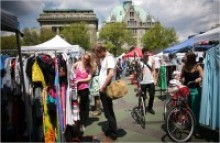THEY came for freshly shucked oysters and straight-off-the-leg prosciutto. They came for clacking vintage typewriters and old LPs repurposed as dog tags and bracelets. And they came, to the Brooklyn Flea in Fort Greene last Saturday, searching for meaning and connection in their rudderless lives.
“Flea markets proliferate a volume of goods needing to be sold and people who are hungry — emotionally and aesthetically — to sort out the meaning of life,” said Michael Prokopow, a history professor at the Ontario College of Art and Design University in Toronto, who teaches a course called “Stuff,” about things and their meaning. “For most people who go on these ritualized scavenger hunts looking for something that they may not know exists, it is a kind of pilgrims’ process through the detritus of the past.”
O.K. So, maybe the situation is not quite that deep. But in recent years, with nearly half a dozen major flea markets springing up across the city, the flea marketing of New York is all but complete.
There is the Brooklyn Flea — actually two flea markets, one in Fort Greene every Saturday and, new this year, another in Williamsburg every Sunday. There is the Hell’s Kitchen Flea Market every weekend, with its gourmet food truck bazaar every second Sunday of the month. There is the Antiques Garage and the West 25th Street Market in Chelsea.
There is the Hester Street Fair in the shadow of Seward Park on the Lower East Side, now in its second year, and the Green Flea all the way up and across town on Columbus Avenue. Dekalb Market, which is set to open this summer in Brooklyn, will feature shipping container storefronts, with vendors selling their wares in what look like urban, Jurassic-size building blocks. And on Saturday BK Festival flea market in Coney Island was to kick off its inaugural season.
The Coney Island flea, according to its owners, Tom Brady and Tom Walker, will distinguish itself with a state fair atmosphere — carnival and pony rides, concerts, car shows, food. But there will be absolutely no hot dogs, out of respect for Nathan’s, the men said in a phone interview, referring to the longtime Coney Island hot-dog seller.
In a city that thrums with opportunity and a veritable buffet of wonderful things to do — theaters! museums! parks! — flea markets have somehow emerged as many people’s first choice of a way to spend the weekend. On Brooklyn Flea’s opening weekend, about 25,000 people filed through the Fort Greene and Williamsburg markets, according to the organizers, and SuChin Pak, a founder of the current Hester Street Fair, estimated that 11,000 people came to her market’s opening day this year.
Originally named after the marchés aux puces — the markets of fleas — on the outskirts of Paris in the late 19th century, flea markets in New York have always been the playground of the city’s creative class. Andy Warhol, among other writers and artists, was known to haunt the Chelsea market. But now the markets have become true scenes, places to see, shop and be seen, all while washing down a $15 lobster roll with some home-brewed hibiscus soda.
The trend has gotten so over the top that, in a video shown in city taxis, the “NBC Nightly News” anchor Brian Williams simultaneously mocked and recommended flea markets to tourists, saying, “Go to one of those Marrakesh-like outdoor artisanal markets.”
“Brooklyn’s a festival this time of year,” Mr. Williams said. “They’re openly making handmade grilled cheese sandwiches, all kinds of leather goods, tin, silver. It’s like a walk back in time!”
WHAT, exactly, is behind the new flea market hegemony? While the foundering economy, the banality of strip-mall and big-box shopping, and the generally whimsical and serendipitous aura of flea markets have all played a role in their popularity, the real reasons behind their rise in New York City are more complicated and hardwired than even the most well-trained scavenger or vintage aficionado might expect, experts say.
Eric Demby, one of the founders of the Brooklyn Flea: “It’s kind of old-fashioned, and it’s about people interacting in the real world, which I think people crave more and more. The more online we go, the more offline interaction becomes a kind of romantic thing.”
Paul Moore, a professor of communication at Ryerson University in Toronto, who studies the history of the mass market: “Personal taste needs an urban space for fashion, like a flea market with an element of playfulness and randomness and spontaneity. We’ve got a nostalgia for outmoded, outdated and anachronistic items, especially when they’ve all been replaced by technologies.”
Old phones, old typewriters, old record players and old cameras, Professor Moore said, are popular among fleagoers. “There’s kind of an amusement value in owning something that has no use anymore,” he said.
And according to Professor Prokopow, the “Stuff” instructor, “It’s this sort of idea of material self-fashioning, a self-curation of life.”
(Another interesting question: Why do so many flea-market experts seem to hail from Canada?)
More than for any goods or services, people often go to flea markets searching for some ineffable quality in an item they recognize only when they see it, like the mid-century modern candy dish their grandmother always set out, or a Rainbow Brite plastic lunchbox that transports them back to a simpler time. And in the process of picking over other people’s junk, they are telling the world something about themselves: “I’m the type of person who ironically buys vintage ‘Star Wars’ figurines,” they seem to say, or “I’m the type of person who appreciates a handcrafted farmers’ table, and homemade lamps made from Mason jars.”
(In the course of reporting, this reporter was the type of person who bought a vintage, vaguely cowgirlesque, blue button-down shirt; a bottle of homemade ginger syrup; a shimmery silver Whiting & Davis purse that broke less than a week later when the reporter was running for a taxi; and upward of $30 in snacks.)
It also didn’t hurt that the inception of some of the newer, trendier flea markets coincided with the rise of the locavore, do-it-yourself and epicurean movements in the city.
Food occupies a significant space at many of the markets, with vendors selling items like Korean tacos, artisanal popsicles, entire pizzas with fresh toppings and, yes, even oysters.
“I think I’m taking my chances, but that’s O.K.; life’s short,” said Jane Keilty, 58, standing at the Fort Greene flea below a large “Oyster girl” pinup poster that read, “Brooklyn Fish Camp.” Ms. Keilty, in town from Massachusetts to visit her daughter for Mother’s Day, ordered “one of each,” slurped the oysters out of their shells and turned to a woman waiting for her order.
“Those were great — so fresh,” she said. “It’s such a great day to be outside and eating oysters.”
Many of the flea markets have actively encouraged a food component as a way to attract new faces, and Mr. Demby and his partner are opening a food-only market on May 21 in their Williamsburg space, which will be called Smorgasburg.
The markets also provide an inexpensive and low-stakes testing ground for vendors to try out their wares and to perfect their recipes. Ms. Pak glided around the Hester Street Fair stands on opening day this month, pointing out vendors who had gotten their start there, like the family of empanada makers who have elevated their recipe to perfection. There was also the stand with creatively stuffed risotto balls that are now the ideal size and consistency.
Simon Tung, a founder of the Macaron Parlour, which features flavors like candied bacon with maple cream cheese and Thai chili, started at the fair’s inaugural weekend last year and already has a regular following. On opening day, an adorable 4 ½-year-old boy named Charles zipped up on a scooter, wearing a fake-leather jacket cuffed to reveal plaid sleeves.
“Why don’t you open up your hand, little guy,” Mr. Tung said, placing a blue Earl Grey macaron — Charles’s favorite — in his palm. “He’s the only kid under 12 who likes Earl Grey, but then again, he’s a sophisticated hipster kid,” Mr. Tung said later, with a laugh.
Charles’s mom, Sasha Safdiah, 34, said she, her husband and their two sons lived down the street and “have never missed a weekend when it’s open.” As her younger son accidentally tried to climb into the wrong stroller and her husband whisked him up in his arms, she added: “They have food and antiques and jewelry, so it’s a good mix. It’s not just old clothes.”
Which brings us to the “curated” concept. Mr. Demby and Ms. Pak stress the thought-out nature of their markets, where vendors are carefully chosen for their diverse array of goods and quality level — but some still have undercurrents of more traditional fleas, what are dismissively called the “tube socks and wrench set.” At the far end of the Hell’s Kitchen Flea Market one day, a man was hawking “cuticle nail and mustache scissors,” and at the other end, a seller began yelling at a woman who had dismissed his estate sale clothes as junk.
“You looking for brand new junk?” he huffed. “Go to Bloomingdale’s. Go down to Chinatown. You can get new junk there.”
ON the whole, however, the new flea markets are a freewheeling space for self-expression. With a camera slung around his neck, Sung Min, 23, scanned the racks of vintage clothes at the Brooklyn Flea in Williamsburg on a sunny afternoon. In many ways, Mr. Min was the physical embodiment of the flea market aesthetic — he wore a typewriter key ring and a sleeveless old T-shirt, both flea purchases, as he talked about the “unique” and “cheaper” clothes he likes to buy there.
“Also, you can have special styles, like him,” Mr. Min said, gesturing to a man wearing green coveralls.
“I’m always amazed by these groups of cool young people, wandering around, looking for stuff, and I think, ‘If you didn’t have this venue, your performance of yourself wouldn’t be as complete,’ ” Professor Prokopow said. He described the phenomenon as “I have something that no one else has. I was different before I got this fantastic blank, but now my differentness is borne on my shoulders.”
But could flea market fatigue soon be upon us? “As long as there are things and people,” Professor Prokopow said, “there will always be places where used things and used people can go.”




















